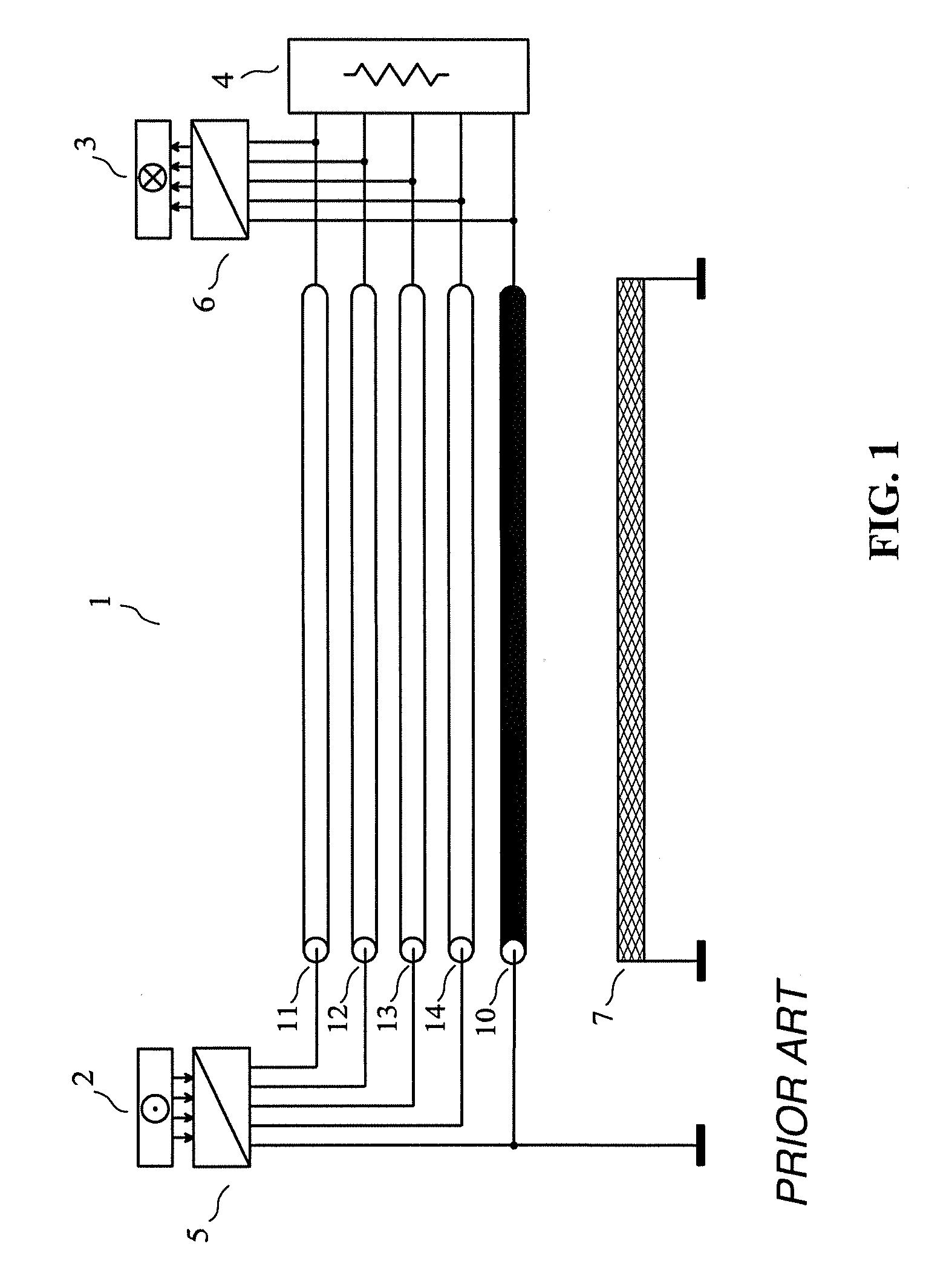Method for pseudo-differential transmission using a non-uniform interconnection
a transmission method and non-uniform technology, applied in the direction of line transmission details, cross-talk reduction, waveguides, etc., can solve the problems of limited bandwidth, substantial reflection of signals, and limited length l of interconnection
- Summary
- Abstract
- Description
- Claims
- Application Information
AI Technical Summary
Benefits of technology
Problems solved by technology
Method used
Image
Examples
first embodiment
[0148]As a first embodiment of a device for implementing the method of the invention, given by way of non-limiting example, we have represented in FIG. 5 a device of the invention comprising an interconnection (1) having n=4 transmission conductors (11) (12) (13) (14) and a return conductor (10) distinct from a reference conductor (7). A transmitting circuit (5) receives at its input the m=4 “input signals of the transmitting circuit” from the m channels of the source (2). The transmitting circuit (5) comprises n output terminals which are connected to the transmission conductors (11) (12) (13) (14) of the interconnection (1), at the near-end of the interconnection (1). The return conductor (10) is grounded at the near-end of the interconnection (1). A termination circuit (4) is connected to the conductors (10) (11) (12) (13) (14) of the interconnection (1), at the far-end of the interconnection (1). A receiving circuit (6) has its n+1 input terminals connected to the conductors (10...
second embodiment
[0160]As a second embodiment of a device for implementing the method of the invention, given by way of non-limiting example, we have represented in FIG. 12 a device of the invention comprising an interconnection (1) having n=2 transmission conductors (11) (12) and a return conductor (10) distinct from a reference conductor (7). A transmitting circuit (5) receives at its input the m=2 “input signals of the transmitting circuit” from the m channels of the source (2). The transmitting circuit (5) comprises n output terminals which are connected to the transmission conductors (11) (12) of the interconnection (1), at the near-end of the interconnection (1). The return conductor (10) is grounded at the near-end of the interconnection (1). A termination circuit (4) is connected to the conductors (10) (11) (12) of the interconnection (1), at the far-end of the interconnection (1). A receiving circuit (6) has its n+1 input terminals connected to the conductors (10) (11) (12) of the interconn...
third embodiment (
Best Mode)
[0172]As a third embodiment of a device for implementing the method of the invention, given by way of non-limiting example and best mode of carrying out the invention, we have represented in FIG. 13 a device of the invention comprising an interconnection (1) having n=4 transmission conductors (11) (12) (13) (14) and a return conductor (10) distinct from a reference conductor (7). A transmitting circuit (5) receives at its input the m=4 “input signals of the transmitting circuit” from the m channels of the source (2). The transmitting circuit (5) comprises n+1 output terminals which are connected to the conductors (10) (11) (12) (13) (14) of the interconnection (1), at the near-end of the interconnection (1). A termination circuit (4) is connected to the conductors (10) (11) (12) (13) (14) of the interconnection (1), at the far-end of the interconnection (1). A receiving circuit (6) has its n+1 input terminals connected to the conductors (10) (11) (12) (13) (14) of the inte...
PUM
 Login to View More
Login to View More Abstract
Description
Claims
Application Information
 Login to View More
Login to View More - R&D
- Intellectual Property
- Life Sciences
- Materials
- Tech Scout
- Unparalleled Data Quality
- Higher Quality Content
- 60% Fewer Hallucinations
Browse by: Latest US Patents, China's latest patents, Technical Efficacy Thesaurus, Application Domain, Technology Topic, Popular Technical Reports.
© 2025 PatSnap. All rights reserved.Legal|Privacy policy|Modern Slavery Act Transparency Statement|Sitemap|About US| Contact US: help@patsnap.com



